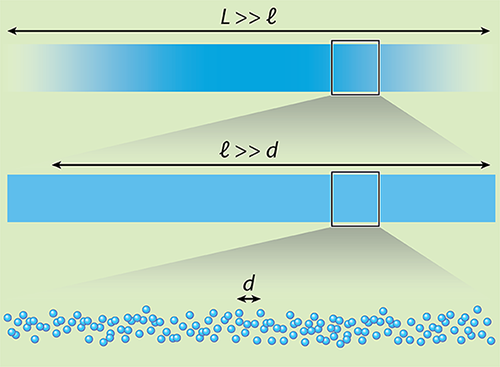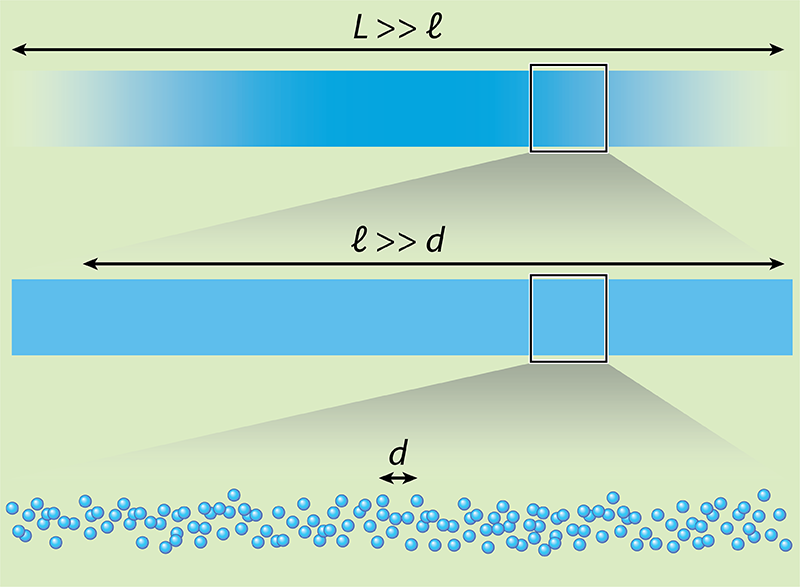A More Efficient Way to Describe Interacting Quantum Particles in 1D
Whether attempting to crack the mystery of high-temperature superconductors or describe a cloud of ultracold atoms, theorists face a similar question: What is the best way to model the behavior of many interacting quantum particles? Most models for such systems are extremely hard to solve analytically, or even simulate on a classical computer. In this context, models for one-dimensional (1D) systems are special because they have mathematical properties that often permit an exact mathematical solution. But even these solvable models aren’t ideal for describing real experiments, particularly those involving many out-of-thermal-equilibrium particles, like a cloud of atoms being released from a trap. A way to realize this description for a large class of widely used 1D models has now been reported in two independent papers, one by Olalla Castro-Alvaredo from the University of London, UK [1], and colleagues and the other by Bruno Bertini from the International School for Advanced Studies in Trieste, Italy, and colleagues [2].
A beautiful method of realizing quantum particles in a 1D setting is to confine ultracold atoms in an elongated (cigar-shaped) trap [3]. If the atoms are bosons, this system can be described by the 1D “delta Bose gas.” In this paradigmatic model, particles move solely along a line. They also mutually repel each other, but only when they are at exactly the same position, hence the “delta” in the model’s name. In the absence of an external trapping potential, this model is exactly solvable in the sense that the particles’ energy spectrum can be calculated [4].
What facilitates solving such models is to use the guess, or ansatz, for the wave function of the particles that was discovered by Hans Bethe in 1931 [5]. The Bethe ansatz expresses the otherwise complicated energy eigenstates of the Hamiltonian of the many-body system in terms of scattering processes of pairs of particles. The eigenstates are expressed in terms of the so-called Bethe equations, which relate the particles’ momenta to the phases they pick up when they bounce against each other. Although theorists have relied on the Bethe-ansatz method for decades, it is not a flexible technique that can be used to model all kinds of experimental situations in 1D. In particular, most Bethe-ansatz solvable models, also known as integrable models, cannot describe atoms in a nonuniform trapping potential or a chain of atomic spins in a spatially varying magnetic field. The reason is that doing so would require adding terms to the Hamiltonian that break the mathematical properties that made the models solvable in the first place.
Castro-Alvaredo et al. [1] and Bertini et al. [2] obtained a more versatile way of dealing with those 1D models by adopting a hydrodynamics approach. Here, one takes a “zoomed-out” view of the particles, such that they no longer appear as individual particles but, instead, as one continuous fluid (Fig. 1). The approach is used in many areas of physics because it replaces the complex problem of describing large numbers of interacting particles with the simpler problem of describing a fluid in terms of local characteristics like its mass density and energy density. In this case, the researchers formulated a general hydrodynamics framework that is applicable to most Bethe-ansatz solvable models. The inputs for this framework are the Bethe equations; the output is a set of differential equations that can be solved to find the dynamics of the fluid-like system. These solutions become more accurate at length scales much greater than the average separation between particles.
The setup of the two papers differs slightly: Castro-Alvaredo et al. worked within the framework of integrable quantum field theory. In contrast, Bertini et al. studied integrable spin chains, which are discrete lattice models in 1D. However, the two approaches rely on the same underlying mathematics and reach analogous results.
What is fascinating about the hydrodynamics framework developed by Castro-Alvaredo et al. and Bertini et al. is that the differential equations they derived have a surprisingly simple and general form. That this was possible was largely unexpected. To see this, it’s worth reviewing two basic assumptions of the hydrodynamics description of any system [6]. The first is that each point in the fluid-like system is (locally) at equilibrium. This allows the system to be entirely characterized by local quantities, such as its particle density, energy density, momentum density, and so on. Each of these densities corresponds to a quantity, or conserved charge, that is conserved for the full system: the total number of particles, the total energy, the total momentum, and so on. The second assumption is that there is a conservation law for each density in the form of a continuity equation, which relates the time evolution of the density to a charge current. Hence, more conserved charges means more continuity equations, which complicates the hydrodynamics description. Now, the Bethe-ansatz-solvable models that Castro-Alvaredo et al. and Bertini et al. studied possess an infinite number of conserved charges. So one might have thought that developing a hydrodynamics approach would quickly turn into an intractable problem. The two teams demonstrate the opposite. By carefully choosing the right mathematical representation for the set of conserved charges, they were able to identify the currents associated with each of them.
The work by the two teams opens exciting possibilities. Specialists in integrable systems and mathematical physics will likely attempt to prove the authors’ hydrodynamics formulation. More generally, the results provide a natural framework with which to describe the time evolution of interacting particles that are out of thermal equilibrium, a class of system that is frequently the focus of modern experiments. One example is the quantum Newton’s cradle [7], in which two 1D clouds of interacting atoms bounce against each other like the balls in the famous desktop office toy. It is known that the right microscopic model to describe this nonequilibrium system is the 1D delta Bose gas. What has been elusive, however, is the ability to calculate (even numerically) the evolution of the atom density for more than a few dozen atoms. The new framework makes such calculations possible for large atomic clouds and for arbitrary interaction strength, which could perhaps allow direct comparisons between model predictions and experimental data. In addition, the simplicity of the hydrodynamics equations found by Castro-Alvaredo et al. and Bertini et al. mean that they can be used by someone who doesn’t have a detailed knowledge of the Bethe-ansatz literature. In fact, the partial differential equations that they found can (in principle) be implemented and solved rather easily on a laptop.
This research is published in Physical Review X and Physical Review Letters.
References
- O. A. Castro-Alvaredo, B. Doyon, and T. Yoshimura, “Emergent Hydrodynamics in Integrable Quantum Systems Out of Equilibrium,” Phys. Rev. X 6, 041065 (2016).
- B. Bertini, M. Collura, J. De Nardis, and M. Fagotti, “Transport in Out-of-Equilibrium Chains: Exact Profiles of Charges and Currents,” Phys. Rev. Lett. 117, 207201 (2016).
- M. A. Cazalilla, R. Citro, T. Giamarchi, E. Orignac, and M. Rigol, “One Dimensional Bosons: From Condensed Matter Systems to Ultracold Gases,” Rev. Mod. Phys. 83, 1405 (2011).
- E. H. Lieb and W. Liniger, “Exact Analysis of an Interacting Bose Gas. I. The General Solution and the Ground State,” Phys. Rev. 130, 1605 (1963).
- H. Bethe, “Zur Theorie der Metalle,” Z. Phys. 71, 205 (1931).
- H. Spohn, Large Scale Dynamics of Interacting Particles (Springer, Berlin, 1991)[Amazon][WorldCat].
- T. Kinoshita, T. Wenger, and D. S. Weiss, “A Quantum Newton's Cradle,” Nature 440, 900 (2006).





